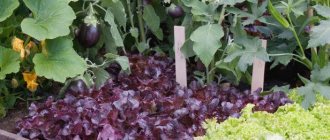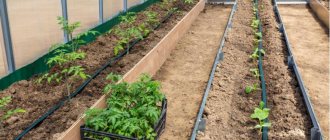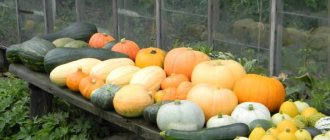The first mentions of mixed plantings came to us with the discovery of America by Columbus. Native American tribes used this method to protect shade-loving plants by planting crops with large leaves nearby to create shelter from the sun's rays.
In Russia, for a long time, the method was used only by individual amateur gardeners, so information about what to plant next to tomatoes is drawn mainly from Western literature and is very contradictory.
There is an opinion that tomato is a monoculture that does not tolerate neighbors, growing well only separately from other species. In fact, tomatoes get along well with garden crops in mixed plantings; it is important to choose the right accompanying plants.
Advantages of mixed plantings
In mixed plantings, each plant has its own important role. Tomato is the main crop. Accompanying plants or companion plants are planted next to it, the function of which is to provide a favorable environment for the growth of the tomato. Growing tomatoes with neighbors has a number of benefits.
- The area allocated for planting is used rationally. This is especially important for greenhouses and small plots of gardening partnerships;
- compacted plantings produce high yields of up to 20 kg per 1 m2;
- plants are less sick and damaged by pests;
- from one plot you can harvest vegetables from early spring until the onset of cold weather;
- soils are less depleted, since different crops absorb different substances from the fertile layer;
- symbiosis (useful interaction) occurs. Plants help each other. Some species repel pests, others loosen the soil or improve its composition.
Why it is necessary to consider the interaction of cultures
There is a whole field of science (allelopathy) that studies the interaction of plants in phytocenoses with each other. The influence can be both direct and indirect.
With close proximity of crops, a direct influence occurs during the release of chemicals (enzymes, organic acids, phenolic compounds, vitamins, sugars) by roots and volatile compounds by leaves.
These substances can have both positive and negative effects on neighbors, oppressing them, so it is necessary to carefully select crops that will grow in the same bed.
In addition to the chemical, there is a physical effect when plants can shade neighbors or create a protective barrier from the wind.
Indirect interaction occurs through the soil. Precursor plants change the composition of the soil, enriching or depleting it, compacting or loosening it, taking and introducing various elements into it. All this must be taken into account when planting tomatoes.
Basic rules for plant proximity
There are many subtle and elusive connections between plants that scientists will have to study for many years to come, but there are also general rules for the proximity of plants that allow all inhabitants of the garden bed to feel comfortable:
- plants with a shallow root system are planted together with crops that obtain nutrition from deep layers of soil in order to avoid competition for nutrients and water;
- crops must belong to different families; the absence of common diseases and pests increases the yield;
- it is important to choose plants that do not shade each other;
- The garden bed should contain protective plants that repel harmful insects and crops that attract bees.
Bad neighbors for tomatoes
Tomatoes are a capricious plant that cannot get along with all crops. Their neighbors must be chosen very carefully. Tomatoes will feel depressed if planted next to the following plants:
- Dill competes with tomatoes for nutrition and takes microelements from them.
- Fennel and kohlrabi produce substances that inhibit tomatoes.
- Broccoli and cauliflower have a suppressive effect.
- Corn shades tomatoes and shares a common pest with it, the bollworm. Some gardeners plant this crop on the north side of the tomatoes so that it protects the plantings from the wind.
- All crops of the nightshade family (peppers, potatoes, eggplants) are relatives of tomatoes, therefore they have a similar type of nutrition, absorbing the same substances from the soil, and they also have common pests.
- Cucumbers are good predecessors of tomatoes, but they are cramped in one bed, they shade the tomatoes and take away their nutrition.
- Peas twine around stems and leaves, interfering with their growth and development.
Undesirable neighborhood
Excessive air and soil humidity negatively affects the condition of plants and provokes the appearance of fungal infections. Because of this, moisture-loving vegetables such as cabbage, cucumbers, zucchini , which require constant and abundant watering, are not suitable neighbors for tomatoes.
It is undesirable to select and add tall, densely leafy plants to these vegetables - they will shade the bushes and interfere with free air circulation, which is absolutely not allowed. For these reasons, climbing legumes are also not suitable as companions : beans and peas , which can cling to the tops with their tendrils and overwhelm the stems.
It is not recommended to compact a tomato plantation with root vegetables, since beets, carrots, radishes, turnips, etc. will take away some of the nutrients, but when competing with such a strong competitor in the garden, they themselves will grow thin.
Horseradish and daikon, and even worse, do not tolerate any proximity near them, release caustic toxins into the soil and oppress everything that grows nearby
Of all root vegetables, the exception is radish , which has a short growing season. Being located in the top layer of soil, it does not in any way interfere with the development of tomato bushes and does not take away their nutrition.
In greenhouse structures, along with tomatoes, eggplants and peppers , primarily bell peppers, less often hot ones. But as you know, all nightshades are attacked by the same pests and suffer from similar diseases, so it is better to place related residents in separate greenhouses or temporary greenhouses.
What can you plant tomatoes next to?
There are many plants that, growing next to tomatoes, increase their yield, improve the quality and structure of the soil, and protect them from pests:
- Basil growing nearby gives tomato fruits a very pleasant flavor, accelerates the growth and ripening of fruits, and repels many pests. It is considered the best neighbor of tomatoes.
- Onions repel flea beetles.
- Garlic protects against spider mites and late blight.
- Beans and asparagus enrich the soil with nitrogen and release substances that destroy many pests.
- Carrots repel pests and improve the composition of the soil.
- Radishes grow juicy and large next to tomatoes, in turn protecting them from diseases.
- Radish repels spider mites.
- Green manure (phacelia, alfalfa), planted between rows, attracts bees, improves soil structure and serves as green fertilizer.
- Marigolds, mint, sage and calendula protect against all parasites.
- Stinging nettle extends the shelf life of fruits and repels pests.
- Parsley protects against aphids.
You can see how tomatoes, cucumbers and peppers grow in one greenhouse in the video.
Great neighborhood
Many people have one protective structure on their plots to obtain earlier vegetable harvests. Therefore, questions arise about how to plant more different plants, while ensuring that they do not oppress each other. What can you plant next to tomatoes if they occupy most of the greenhouse?
Video: What can be planted next to corn
In greenhouses, gardeners combine plantings with peppers. How justified is this?
Pepper and tomato are good neighbors because:
- tomato saves pepper from aphids;
- the conditions of detention are similar, the same temperature and humidity are needed;
- Both crops need garter, so you can stretch one trellis.
This proximity is acceptable if the vegetables are well protected from diseases and pests.
Note! If you plant basil next to tomatoes, pests will be less likely to attack them. Experts also say that the taste of tomatoes benefits from such proximity.
What else can you plant? Watermelons and melons get along well in the same greenhouse with tomatoes. It is convenient to plant lettuce, radishes, onions, spinach, and dill nearby in the greenhouse. They can be placed indoors even before the tomatoes are placed there. It must be remembered that dill should be removed in time so that adult plants do not take away nutrition from the main crop.
Peppers and tomatoes are great allies
What can be planted together with tomatoes in the same greenhouse? In spring you can get a harvest of Chinese cabbage, which does well nearby. In a greenhouse you can plant the following around tomatoes:
- legumes;
- strawberries;
- spices.
You should pay attention to ensure that the tomatoes do not shade their younger brothers from the sun. Dill can be planted next to tomato bushes if it is removed before the tomatoes begin to set.
And every gardener should know what to plant tomatoes with in a garden bed in open ground. There are plants that are beneficial for tomatoes when planted together. To cope with nematodes, you should plant asparagus nearby, which releases repellent volatile substances. Phytoncides of onions and garlic are useful in fighting infections in any garden; for example, such neighbors will save from late blight and spider mites. The cutworm pest does not tolerate the presence of bird cherry. Basil repels pests.
Good neighbors of tomatoes in open ground:
- beans;
- radish;
- sorrel;
- pepper;
- parsley;
- borage;
- chives;
- garlic;
- salad;
- mustard;
- nettle.
It will benefit the plants if you plant mint, sage, and calendula next to the tomato. In open ground, tomatoes go well with pumpkin, melon, and watermelons. Planting tomatoes and strawberries makes it possible to get two crops from one area: berries and vegetables. It should be noted that in this case there is no need to choose tall varieties of tomatoes so that they do not block the strawberries from the sun. The row spacing should provide light access to the berry bushes.
You can plant tomatoes, carrots, radishes and beets in one bed.
Note! Basil, lemon balm, mint, savory, and sage improve the taste of tomatoes.
Tomato saves plants from pests and diseases. What to plant next to tomatoes to prevent crop loss? If at least one tomato grows next to gooseberries or currants, then there will be no moth or sawfly.
It will be good to have a zucchini near the tomato; it will be saved from aphids, moths, and sawflies.
Advice. The cabbage plant is afraid of the smell of tomatoes, so in the fight against it it is best to use infusions of the tops.
You should grow tomatoes next to raspberry bushes only if they do not create shade for the vegetable. There is no need to plant closely. The raspberry patch should be located a meter wide from the tomato bush so that the berries can be easily picked. In addition, raspberry roots will not take away nutrition from the tomato.
Nettles are a good neighbor
Interesting! If nettles grow next to tomato bushes, there is no need to rush to remove them. It improves the quality of tomato juice and keeps it longer.
Making the right choice
Choosing the right garden neighbors is a real art. The plant community must be composed in such a way that it represents an autonomous structure, where each crop will play its role, bringing a certain benefit.
Some species enrich and loosen the soil, others repel pests, and others accelerate the ripening of neighboring fruits.
The planting structure should look like this:
- the bed must be at least 1 m wide;
- tomato is the main crop and is planted in the center of the bed;
- Companion plants are planted on the sides of the designated area. These should be low-growing plants with a rapid ripening period in order to have time to collect them by the time the main crop ripens (onions, radishes, parsley);
- As accompanying crops, it is best to use plants with fibrous root systems, which help retain moisture in the soil longer and species that repel pests (garlic).
Tomatoes work well with spinach, chives, bush beans and endive. It is good to plant them around the perimeter of the garden bed.
There are many examples of joint plantings. One of the most famous combinations, created by the German gardener Hubmann, is tomatoes (1 row in the center of the bed) combined with beans (3 rows) and radishes (4 rows).
Features of the neighborhood in a greenhouse with pepper and cucumber
The peculiarity of greenhouses is that in a small area it is necessary to grow a large number of plants, often incompatible with each other.
Tomatoes have to live next to peppers, eggplants and cucumbers.
It is easy to avoid the negative influence of these cultures on each other. Between “bad neighbors” you can plant small areas with compatible companion plants. Greens are planted between the rows: parsley, basil, lettuce.
Each vegetable has its own “apartment”
For those who are still trying to grow poorly compatible vegetables in one greenhouse, there is a way out. This is the organization of space . What can you use to plant tomatoes in a greenhouse? The most “greenhouse” plants are tomatoes, cucumbers, peppers and eggplants. Their compatibility leaves much to be desired, so they should be separated from each other .
If the greenhouse has two entrances on opposite sides , it is easier to place crops in it. If it is wide enough, three beds are made. Tomatoes are planted in the middle - this part of the greenhouse is best ventilated. Peppers are placed on the north side, cucumbers or eggplants are placed on the south bed. Although it is better to exclude cucumbers .
If there is one door in the greenhouse , and only a window on the opposite side, the crops can be arranged in the following order: tomatoes are planted near the doors, they should be separated from the rest of the area either by film, or by slate or plywood. The best material is film.
Next, cucumbers are planted, followed by eggplants - both vegetables are very heat-loving and will do well in the middle. And last but not least, peppers are planted near the window; they prefer a cooler atmosphere.
When placing crops that are not very compatible in one greenhouse, you must be prepared for a slight decrease in the yield of each crop.
Today, greenhouse manufacturers offer various designs, in particular internal ones. Using partition modules, you can create separate rooms with the desired microclimate in them, which will allow you to combine “incompatible things” in one greenhouse and not have to think about what to plant tomatoes with.
You can also find out what can be planted in a greenhouse with eggplants, cucumbers, or additionally read about tomatoes, cucumbers and peppers in one greenhouse.
The best neighbors of tomatoes in open ground
- The area for sowing in open ground is usually large, but the beds are located close to each other, so the question arises: what crops will tomatoes feel comfortable next to?
- Carrots, beets, radishes, garlic, celery, radishes, basil, parsley and cabbage are the best neighbors of tomatoes. They do not shade the bushes and have a positive or neutral effect on tomatoes.
- Herbs with a pronounced aroma (melissa, basil, thyme), planted around the perimeter of the garden, improve the taste and shelf life of fruits, and repel insect pests.
- Do not plant potatoes, fennel, dill and cucumbers next to each other. Although gardeners have very different opinions about the last vegetable. Many vegetable growers successfully grow cucumbers in close proximity to tomatoes.
What to plant next to tomatoes in a greenhouse
To grow tomatoes in a closed room with its own microclimate, and even with neighbors, you need to clearly remember the requirements of the main crop. Tomatoes prefer good lighting (however, cloudy weather is not critical for them), moderate air temperature, frequent ventilation, regular fertilizing with fertilizers and watering at the root. When choosing greenhouse neighbors, you need to choose plants with similar requirements. When deciding what else can be planted in the greenhouse along with tomatoes, you also need to take into account the size of the room, the material of the roof and walls, the presence of additional doors and windows.
- Growing tomatoes in a greenhouse - the secrets of a bountiful harvest
Do you want to reap a rich harvest of delicious fruits? These rules of agricultural technology will help you with this!
So, what can you use to plant tomatoes in a greenhouse? Following the example described above with the open ground option, in a greenhouse, to begin with, in the same way, before planting tomatoes, you can densely sow early and fast-growing crops - onions and garlic for feathers, salads, radishes, kale . When the time comes for tomato seedlings, just make room for them among these crops and for at least another month you can harvest the “pioneers” while the tomatoes are just developing.
What else? Almost all the same crops that we described above, if you prefer to grow them in a greenhouse - melons, legumes, greens, cabbage, strawberries, herbs ... The main thing is not to forget to tie up tall and voluminous tomato bushes so that they do not block the sun smaller brothers in the greenhouse.
- Joint planting in a greenhouse, or What vegetables can be planted nearby
We select suitable neighbors for vegetables grown in greenhouses, greenhouses, and tunnels.
Let's look at some of the most frequently asked questions about possible neighbors of tomatoes in a greenhouse.
Is it possible to plant tomatoes and cucumbers next to each other?
In principle, cucumbers and tomatoes in a greenhouse do not interfere with each other. The main problem may be their different microclimate requirements. Judge for yourself.
Tomatoes:
- prefer moderate temperatures and dry air,
- require regular ventilation of the greenhouse,
- very demanding when it comes to fertilization,
- love watering at the root.
cucumbers:
- prefer high temperatures and high humidity,
- cannot tolerate drafts,
- may well do without other heavy fertilizing, provided that organic matter is added in a timely manner,
- love abundant watering and sprinkling.
- How to care for cucumbers in a greenhouse and greenhouse
What needs to be done to ensure that cucumbers in a greenhouse or greenhouse are a success?
Therefore, if possible, it is better to plant these crops in different greenhouses or take the cucumbers out into the open ground under a film.
Is it possible to plant peppers next to tomatoes?
Tomatoes and peppers have fairly similar requirements for humidity and temperature conditions in a greenhouse. In addition, peppers, like tomatoes, need garter. So a common trellis is quite suitable for them - stretch the wire at a height of about 2 m.
Tomatoes will also help repel aphids, which love peppers.
- Features of growing sweet peppers in a greenhouse
Do you have to buy sweet peppers and pay exorbitant prices for them? Enough tolerating this! Grow your own paprika in a greenhouse.
However, peppers and tomatoes belong to the same family (Solanaceae), which means they have the same diseases and pests that will easily migrate from one crop to another. If you are able to provide good protection from insects and infections to both, feel free to plant these plants together (a checkerboard pattern is recommended). Having marigolds around the perimeter of the structure will also help.
Just remember that both crops love light, so do not thicken the plantings, and also trim the plants in a timely and competent manner.











